Horseshoe Canyon
excerpted from our book
Canyonlands National Park
Favorite Jeep Roads & Hiking Trails
pages 279-282
|
Buy book directly from the author!
Canyonlands National Park
Favorite Jeep Roads & Hiking Trails
- has access info for 75 trailheads
- 56 detailed trail maps
- 241 photographs
- loads of driving and hiking tips
|
regularly $14.95
now on sale for only
$11.95
click here
for book orders
|
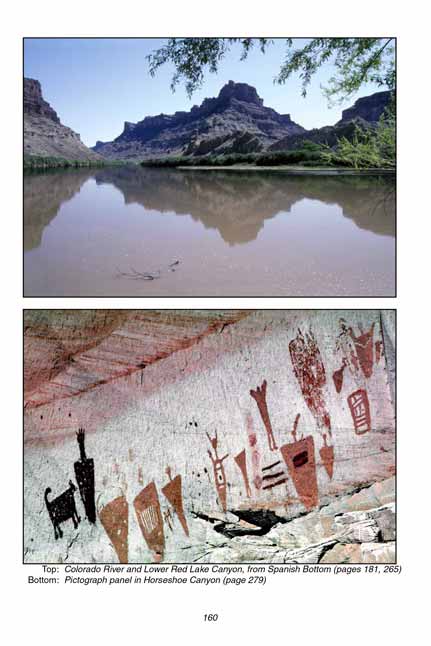
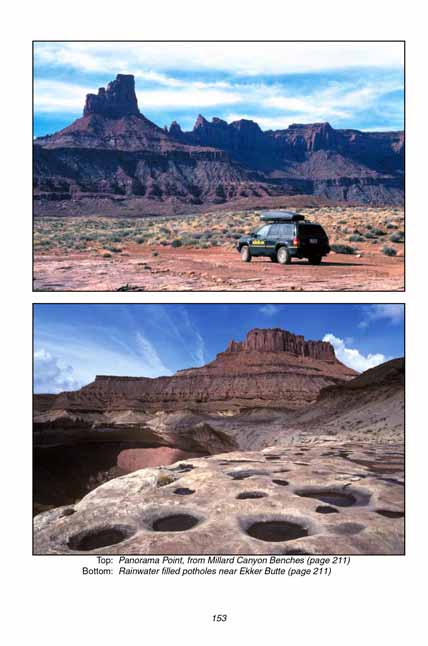
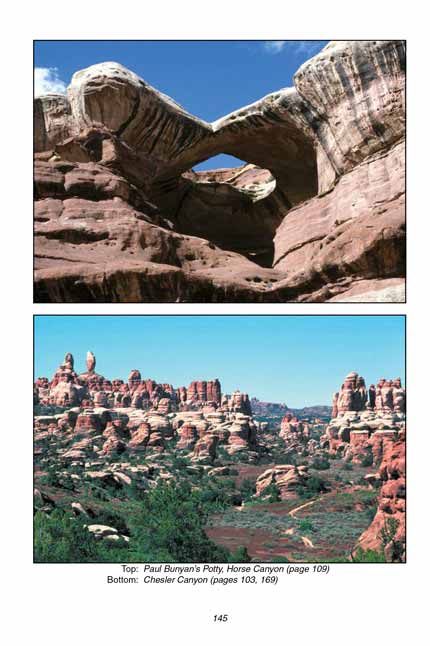
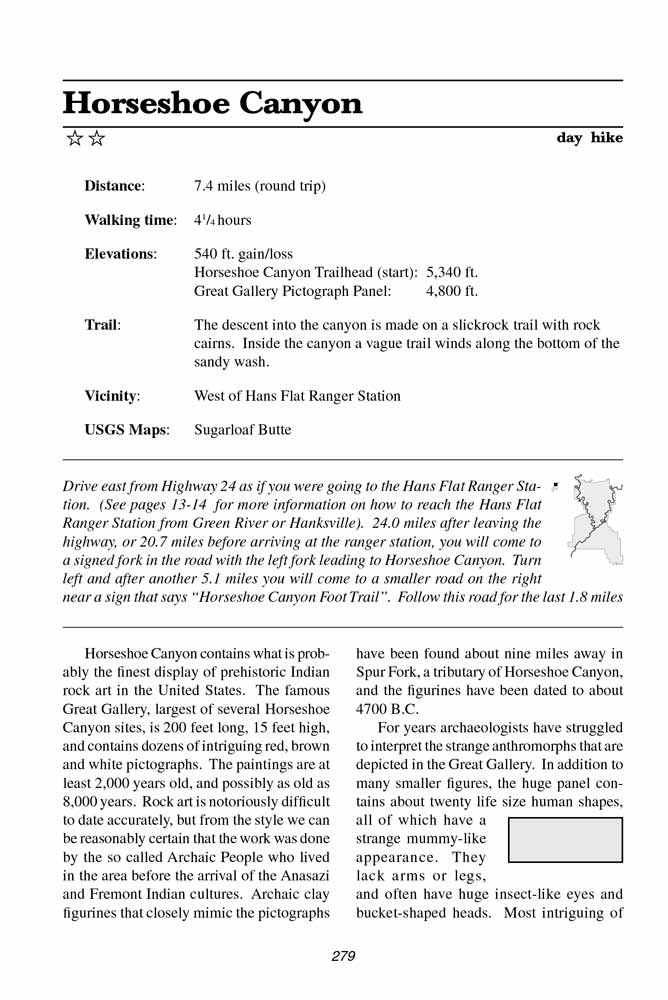 Horseshoe Canyon contains what is probably the finest display of prehistoric Indian rock art in the United States. The famous Great Gallery, largest of several Horseshoe Canyon sites, is 200 feet long, 15 feet high, and contains dozens of intriguing red, brown and white pictographs. The paintings are at least 2,000 years old, and possibly as old as 8,000 years. Rock art is notoriously difficult to date accurately, but from the style we can be reasonably certain that the work was done by the so called Archaic People who lived in the area before the arrival of the Anasazi and Fremont Indian cultures. Archaic clay figurines that closely mimic the pictographs have been found about nine miles away in Spur Fork, a tributary of Horseshoe Canyon, and the figurines have been dated to about 4700 B.C.
Horseshoe Canyon contains what is probably the finest display of prehistoric Indian rock art in the United States. The famous Great Gallery, largest of several Horseshoe Canyon sites, is 200 feet long, 15 feet high, and contains dozens of intriguing red, brown and white pictographs. The paintings are at least 2,000 years old, and possibly as old as 8,000 years. Rock art is notoriously difficult to date accurately, but from the style we can be reasonably certain that the work was done by the so called Archaic People who lived in the area before the arrival of the Anasazi and Fremont Indian cultures. Archaic clay figurines that closely mimic the pictographs have been found about nine miles away in Spur Fork, a tributary of Horseshoe Canyon, and the figurines have been dated to about 4700 B.C.
For years archaeologists have struggled to interpret the strange anthromorphs that are depicted in the Great Gallery
of Horseshoe Canyon. In addition to many smaller figures, the huge panel contains about twenty life size human shapes, all of which have a strange mummy-like appearance. They lack arms or legs, and often have huge insect-like eyes and bucket-shaped heads. Most intriguing of all is the figure known as the “Holy Ghost”. This seven-foot-high painting stands out among the others because of its size and its ethereal appearance. Perhaps it was intended to portray a revered ancestor, or a mythical deity.
From the car parking area, the trail proceeds into
Horseshoe Canyon along an old jeep road that was originally built in the 1920s by the Phillips Petroleum Company. Phillips was one of many oil companies that drilled unsuccessfully for oil in the area during the first half of the last century. 0.2 mile from the trailhead you will pass an old iron gate that has since been erected to keep vehicles out of the canyon, and another 0.4 mile beyond the gate the trail passes on old water tank. The water tank was part of a pumping system built by sheep ranchers in the early 1940s to bring water up to the pastures above Horseshoe Canyon. The system never worked well, however, and it was abandoned after just a few years.
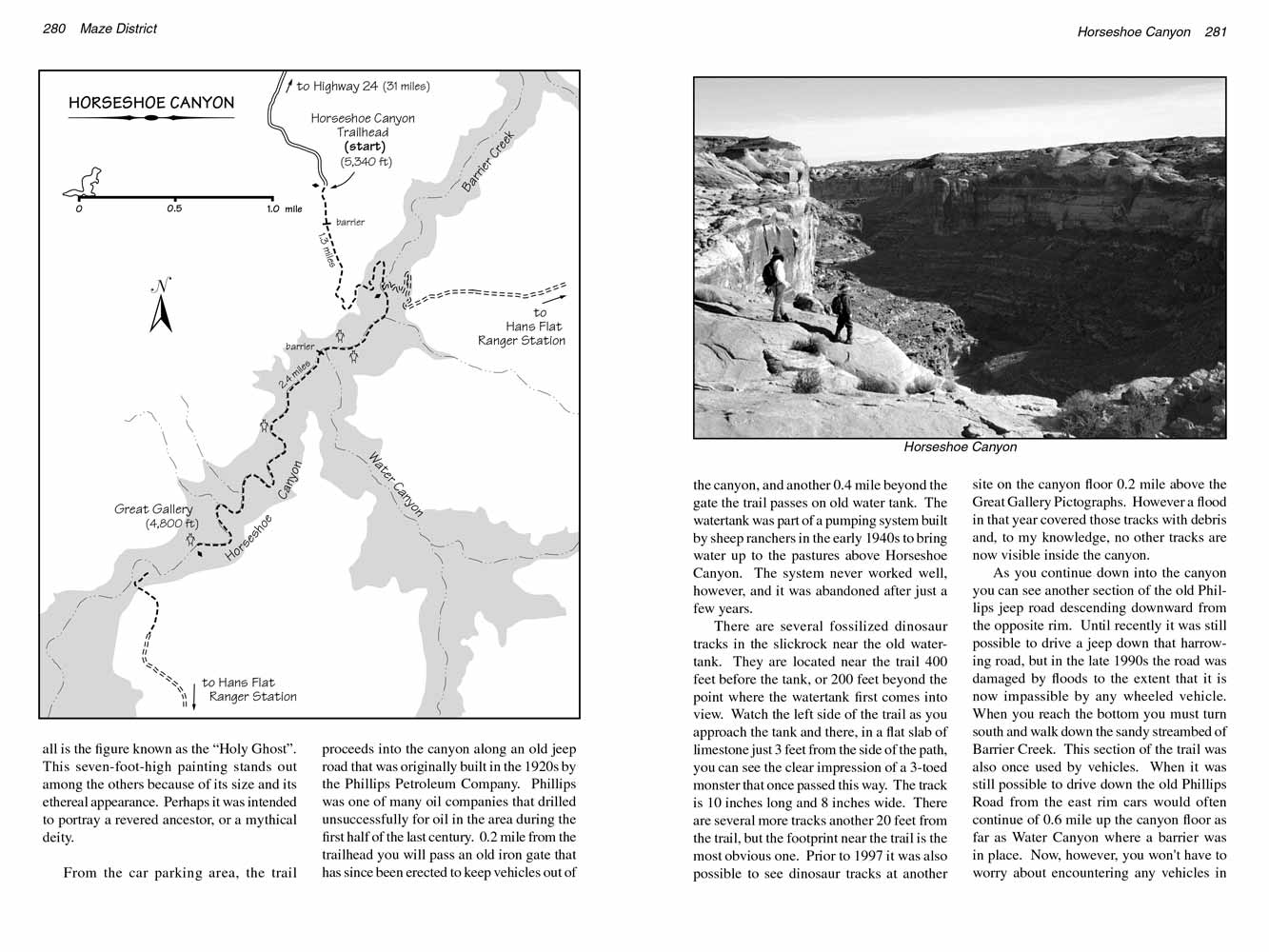 There are several fossilized dinosaur tracks in the slickrock near the old water tank. They are located near the trail 400 feet before the tank, or 200 feet beyond the point where the water tank first comes into view. Watch the left side of the trail as you approach the tank and there, in a flat slab of limestone just 3 feet from the side of the path, you can see the clear impression of a 3-toed monster that once passed this way. The track is 10 inches long and 8 inches wide. There are several more tracks another 20 feet from the trail, but the footprint near the trail is the most obvious one. Prior to 1997 it was also possible to see dinosaur tracks at another site on the
Horseshoe Canyon floor 0.2 mile above the Great Gallery Pictographs. However a flood in that year covered those tracks with debris and, to my knowledge, no other tracks are now visible inside the canyon.
There are several fossilized dinosaur tracks in the slickrock near the old water tank. They are located near the trail 400 feet before the tank, or 200 feet beyond the point where the water tank first comes into view. Watch the left side of the trail as you approach the tank and there, in a flat slab of limestone just 3 feet from the side of the path, you can see the clear impression of a 3-toed monster that once passed this way. The track is 10 inches long and 8 inches wide. There are several more tracks another 20 feet from the trail, but the footprint near the trail is the most obvious one. Prior to 1997 it was also possible to see dinosaur tracks at another site on the
Horseshoe Canyon floor 0.2 mile above the Great Gallery Pictographs. However a flood in that year covered those tracks with debris and, to my knowledge, no other tracks are now visible inside the canyon.
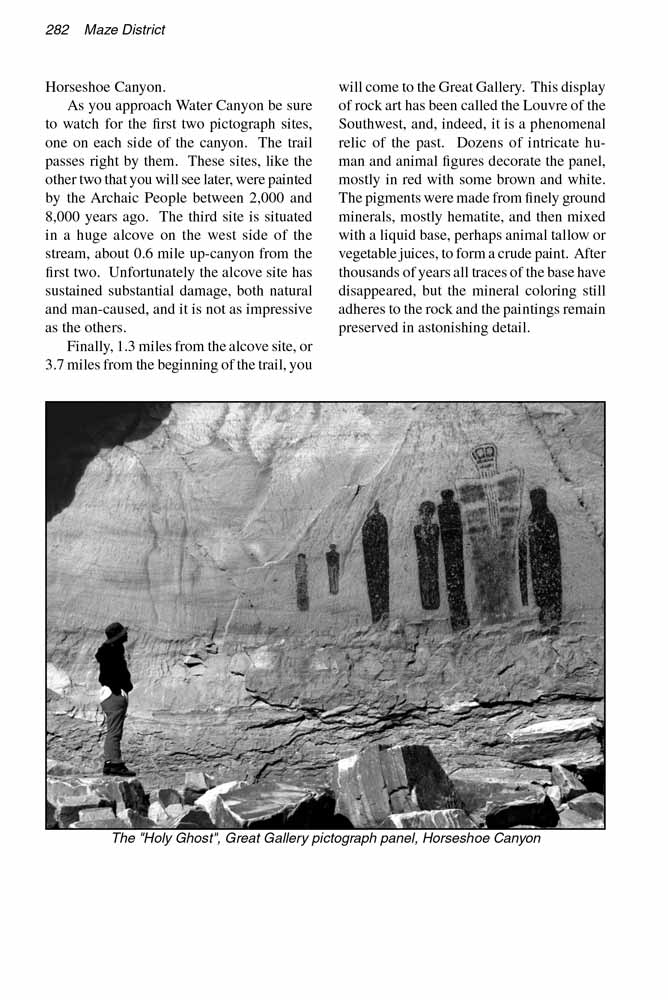 As you continue down into the canyon you can see another section of the old Phillips jeep road descending downward from the opposite rim. Until recently it was still possible to drive a jeep down that harrowing road
into Horseshoe Canyon, but in the late 1990s the road was damaged by floods to the extent that it is now impassible by any wheeled vehicle. When you reach the bottom you must turn south and walk down the sandy streambed of Barrier Creek. This section of the trail was also once used by vehicles. When it was still possible to drive down the old Phillips Road from the east rim cars would often continue of 0.6 mile up the
Horseshoe Canyon floor as far as Water Canyon where a barrier was in place. Now, however, you won't have to worry about encountering any vehicles in Horseshoe Canyon.
As you continue down into the canyon you can see another section of the old Phillips jeep road descending downward from the opposite rim. Until recently it was still possible to drive a jeep down that harrowing road
into Horseshoe Canyon, but in the late 1990s the road was damaged by floods to the extent that it is now impassible by any wheeled vehicle. When you reach the bottom you must turn south and walk down the sandy streambed of Barrier Creek. This section of the trail was also once used by vehicles. When it was still possible to drive down the old Phillips Road from the east rim cars would often continue of 0.6 mile up the
Horseshoe Canyon floor as far as Water Canyon where a barrier was in place. Now, however, you won't have to worry about encountering any vehicles in Horseshoe Canyon.
As you approach Water Canyon be sure to watch for the first two pictograph sites, one on each side of the canyon. The trail passes right by them. These sites, like the other two that you will see later, were painted by the Archaic People between 2,000 and 8,000 years ago. The third site is situated in a huge alcove on the west side of the stream, about 0.6 mile up-canyon from the first two. Unfortunately the alcove site has sustained substantial damage, both natural and man-caused, and it is not as impressive as the others.
Finally, 1.3 miles from the alcove site, or 3.7 miles from the beginning of the
Horseshoe Canyon trail, you will come to the Great Gallery. This display of rock art has been called the Louvre of the Southwest, and, indeed, it is a phenomenal relic of the past. Dozens of intricate human and animal figures decorate the panel, mostly in red with some brown and white. The pigments were made from finely ground minerals, mostly hematite, and then mixed with a liquid base, perhaps animal tallow or vegetable juices, to form a crude paint. After thousands of years all traces of the base have disappeared, but the mineral coloring still adheres to the rock and the paintings remain preserved in astonishing detail.
Note to web developers: You may copy this material onto your site, but in return please include a link to my home page
www.utahtrails.com. Thank you, David Day (utahdavidday at gmail.com)
Click here to see more trails in
Canyonlands National Park
© Rincon Publishing Company, all rights reserved
|



 Horseshoe Canyon contains what is probably the finest display of prehistoric Indian rock art in the United States. The famous Great Gallery, largest of several Horseshoe Canyon sites, is 200 feet long, 15 feet high, and contains dozens of intriguing red, brown and white pictographs. The paintings are at least 2,000 years old, and possibly as old as 8,000 years. Rock art is notoriously difficult to date accurately, but from the style we can be reasonably certain that the work was done by the so called Archaic People who lived in the area before the arrival of the Anasazi and Fremont Indian cultures. Archaic clay figurines that closely mimic the pictographs have been found about nine miles away in Spur Fork, a tributary of Horseshoe Canyon, and the figurines have been dated to about 4700 B.C.
Horseshoe Canyon contains what is probably the finest display of prehistoric Indian rock art in the United States. The famous Great Gallery, largest of several Horseshoe Canyon sites, is 200 feet long, 15 feet high, and contains dozens of intriguing red, brown and white pictographs. The paintings are at least 2,000 years old, and possibly as old as 8,000 years. Rock art is notoriously difficult to date accurately, but from the style we can be reasonably certain that the work was done by the so called Archaic People who lived in the area before the arrival of the Anasazi and Fremont Indian cultures. Archaic clay figurines that closely mimic the pictographs have been found about nine miles away in Spur Fork, a tributary of Horseshoe Canyon, and the figurines have been dated to about 4700 B.C.
 There are several fossilized dinosaur tracks in the slickrock near the old water tank. They are located near the trail 400 feet before the tank, or 200 feet beyond the point where the water tank first comes into view. Watch the left side of the trail as you approach the tank and there, in a flat slab of limestone just 3 feet from the side of the path, you can see the clear impression of a 3-toed monster that once passed this way. The track is 10 inches long and 8 inches wide. There are several more tracks another 20 feet from the trail, but the footprint near the trail is the most obvious one. Prior to 1997 it was also possible to see dinosaur tracks at another site on the
Horseshoe Canyon floor 0.2 mile above the Great Gallery Pictographs. However a flood in that year covered those tracks with debris and, to my knowledge, no other tracks are now visible inside the canyon.
There are several fossilized dinosaur tracks in the slickrock near the old water tank. They are located near the trail 400 feet before the tank, or 200 feet beyond the point where the water tank first comes into view. Watch the left side of the trail as you approach the tank and there, in a flat slab of limestone just 3 feet from the side of the path, you can see the clear impression of a 3-toed monster that once passed this way. The track is 10 inches long and 8 inches wide. There are several more tracks another 20 feet from the trail, but the footprint near the trail is the most obvious one. Prior to 1997 it was also possible to see dinosaur tracks at another site on the
Horseshoe Canyon floor 0.2 mile above the Great Gallery Pictographs. However a flood in that year covered those tracks with debris and, to my knowledge, no other tracks are now visible inside the canyon.
 As you continue down into the canyon you can see another section of the old Phillips jeep road descending downward from the opposite rim. Until recently it was still possible to drive a jeep down that harrowing road
into Horseshoe Canyon, but in the late 1990s the road was damaged by floods to the extent that it is now impassible by any wheeled vehicle. When you reach the bottom you must turn south and walk down the sandy streambed of Barrier Creek. This section of the trail was also once used by vehicles. When it was still possible to drive down the old Phillips Road from the east rim cars would often continue of 0.6 mile up the
Horseshoe Canyon floor as far as Water Canyon where a barrier was in place. Now, however, you won't have to worry about encountering any vehicles in Horseshoe Canyon.
As you continue down into the canyon you can see another section of the old Phillips jeep road descending downward from the opposite rim. Until recently it was still possible to drive a jeep down that harrowing road
into Horseshoe Canyon, but in the late 1990s the road was damaged by floods to the extent that it is now impassible by any wheeled vehicle. When you reach the bottom you must turn south and walk down the sandy streambed of Barrier Creek. This section of the trail was also once used by vehicles. When it was still possible to drive down the old Phillips Road from the east rim cars would often continue of 0.6 mile up the
Horseshoe Canyon floor as far as Water Canyon where a barrier was in place. Now, however, you won't have to worry about encountering any vehicles in Horseshoe Canyon.